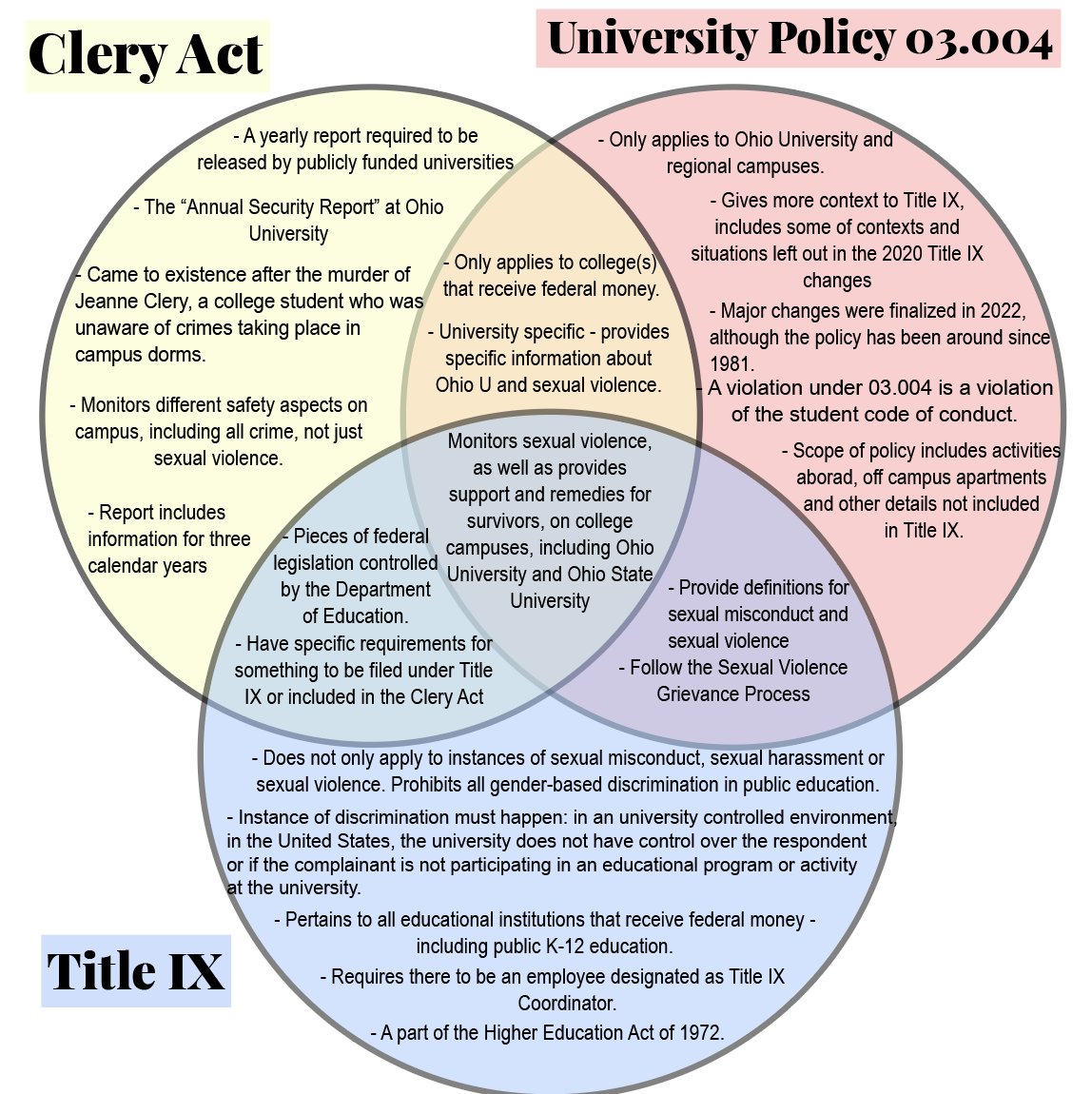Defining Sexual Violence
Illustration by Emily Crebs.
Editor’s Note: This story is part of a collaboration with Ohio State University’s The Lantern. Student Perceptions of Sexual Violence On Campus, a look at the state of sexual violence prevalence, education and reporting on our respective campuses.
Editor’s Note: The Venn diagram was updated to note that University policy 03.004 has been in place since 1981.
Sexual Violence:
According to National Sexual Violence Resource Center,
Sexual violence means that someone forces or manipulates someone else into unwanted sexual activity without their consent. Reasons someone might not consent include fear, age, illness, disability, and/or influence of alcohol or other drugs. Anyone can experience sexual violence including: children, teens, adults, and elders. Those who sexually abuse can be acquaintances, family members, trusted individuals or strangers.
Forms of Sexual Violence:
Rape or sexual assault
Child sexual assault and incest
Intimate partner sexual assault
Unwanted sexual contact/touching
Sexual harassment
Sexual exploitation
Showing one’s genitals or naked body to other(s) without consent
Masturbating in public
Watching someone in a private act
without their knowledge or permission
Harassment:
According to the EEOC,
Unwelcome sexual advances, requests for sexual favors, and other verbal or physical conduct of a sexual nature when:
Submission to such conduct is made either explicitly or implicitly a term or condition of an individual's employment, or
Submission to or rejection of such conduct by an individual is used as a basis for employment decisions affecting such individual, or
Such conduct has the purpose or effect of unreasonably interfering with an individual's work performance or creating an intimidating, hostile, or offensive working environment.
Sexual Assault:
According to RAINN,
The term sexual assault refers to sexual contact or behavior that occurs without explicit consent of the victim. Some forms of sexual assault include:
Attempted rape
Fondling or unwanted sexual touching
Forcing a victim to perform sexual acts, such as oral sex or penetrating the perpetrator’s body
Penetration of the victim’s body, also known as rape.
Rape:
According to RAINN,
Rape is a form of sexual assault, but not all sexual assault is rape. The term rape is often used as a legal definition to specifically include sexual penetration without consent. For its Uniform Crime Reports, the FBI defines rape as “penetration, no matter how slight, of the vagina or anus with any body part or object, or oral penetration by a sex organ of another person, without the consent of the victim.”
Dating Violence:
According to CDC,
It occurs between two people in a close relationship and includes:
Physical violence
Examples: Hitting, kicking, pushing
Sexual violence
Examples: Forcing a partner to take part in a sex act
Psychological abuse
Examples: Name-calling, insulting, threatening
Stalking
Examples: Repeated unwanted or threatening phone calls or messages, showing up unwanted
Dating violence can happen in person or electronically including repeated texting or posting sexual pictures of a partner online without their permission.
Consent:
According to Planned Parenthood,
Consent means actively agreeing to be sexual with someone. Consent lets someone know that sex is wanted. Sexual activity without consent is rape or sexual assault.
Without consent, sexual activity (including oral sex, genital touching, and vaginal or anal penetration) is sexual assault or rape.
Consent is…
Freely given. Consenting is a choice you make without pressure, manipulation, or under the influence of drugs or alcohol.
Reversible. Anyone can change their mind about what they feel like doing, anytime. Even if you’ve done it before, and even if you’re both naked in bed.
Informed. You can only consent to something if you have the full story. For example, if someone says they’ll use a condom and then they don’t, there isn’t full consent.
Enthusiastic. When it comes to sex, you should only do stuff you WANT to do, not things that you feel you’re expected to do.
Specific. Saying yes to one thing (like going to the bedroom to make out) doesn’t mean you’ve said yes to others (like having sex).
A Venn diagram showing some of the similarities and differences between the Clery Act, Ohio U University policy 03.004 and Title IX. Illustration by Izzy Keller.


